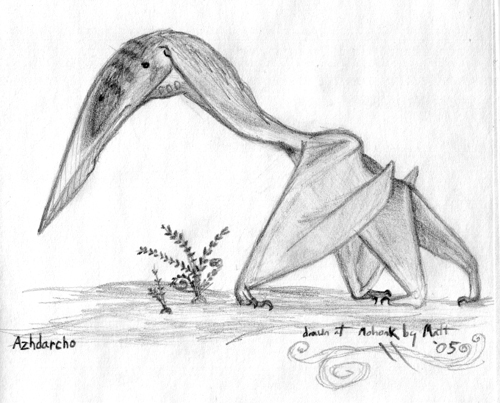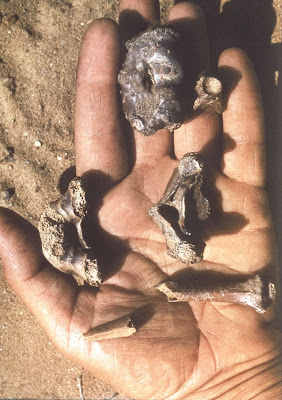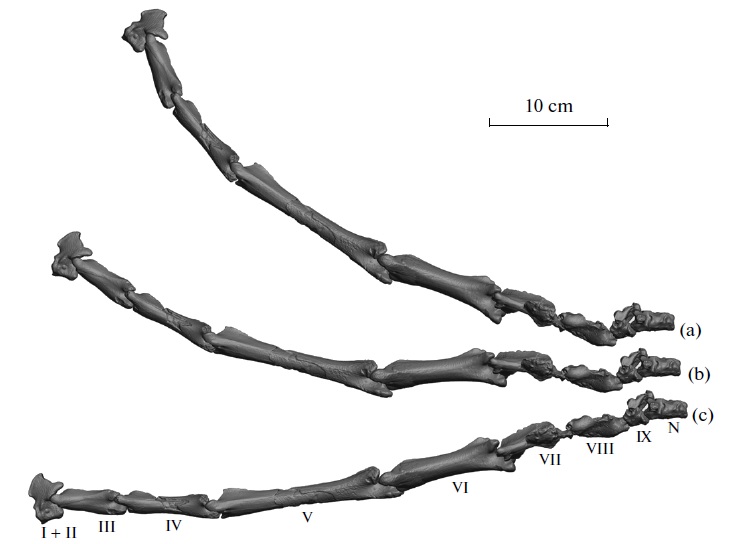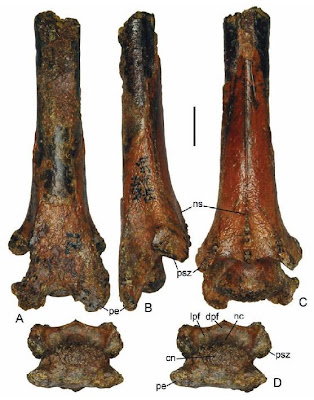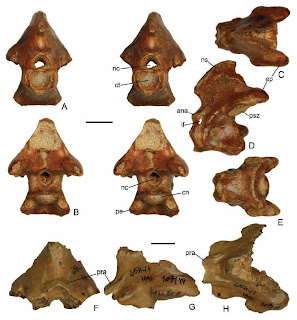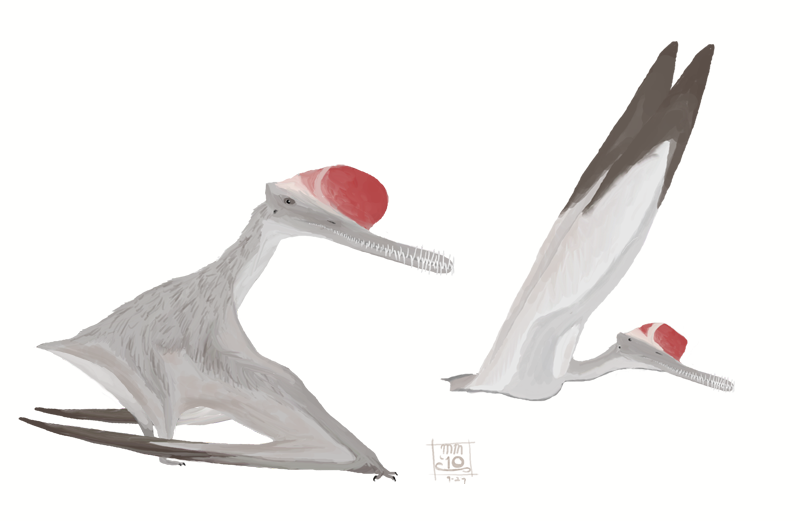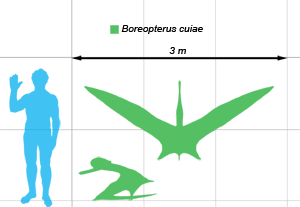[Recent Entries][Archive][Friends][User Info]
April 30th, 2014
| April 30th, 2014 | |
|---|---|
| 12:54 pm [industrialterro] [Link] |
Azhdarcho Azhdarcho /ɑːʒˈdɑrxoʊ/ is a genus of pterodactyloid pterosaur from the late Cretaceous Period of the Bissekty Formation (middle Turonian stage, about 92 million years ago) of Uzbekistan. It is known from fragmentary remains including the distinctive, elongated neck vertebrae that characterizes members of the family Azhdarchidae, which also includes such giant pterosaurs as Quetzalcoatlus. The name Azhdarcho comes from the Uzbek word azhdarkho [adʒˈdarχɒ], the name of a dragon in Uzbek mythology. The type species is Azhdarcho lancicollis. The specific epithet lancicollis is derived from the Latin words lancea (meaning "lance" or "spear") and collum ("neck"). The fossil remains of Azhdarcho were recovered in the Kyzyl Kum desert (from the Taykarshinskaya unit of the Bissekty Formation) by Lev A. Nesov during expeditions to Central Asia in 1974-1981. The type specimen, given the catalog number TsNIGRmuzey 1/11915, consists of an anterior neck vertebra. Twelve paratypes were referred, including several other neck vertebrae, elements from the wing and leg, and pieces of the jaw. These specimens, along with other vertebrate fossils collected during the expeditions, were deposited at the F.N. Chernyshev Central Geologic Exploration Museum in St. Petersberg. In his description of the type specimen of Azhdarcho lancicollis, Nesov noted its distinctive neck vertebrae, which are extremely elongated and round in cross section at mid-length. He pointed out similar characteristics in several other pterosaurs, and used them to erect the new subfamily Azhdarchinae, within the Pteranodontidae. Nesov also referred Quetzalcoatlus and Arambourgiania (then known as Titanopteryx) to this subfamily, which was subsequently re-classified as the family Azhdarchidae. He also suggested that similar, thin-walled pterosaur bones from the Lance Formation of Wyoming could be assigned to a species of Azhdarcho, using this as evidence of commonalities between the fauna of Late Cretaceous central Asia and western North America. However, subsequent research has not followed this suggestion, and A. lancicollis is the only currently recognized species of Azhdarcho. In the original description of Azhdarcho, Nesov noted that because of the way the vertebrae articulated, the pterosaur would have had very limited flexibility in the neck. Azhdarcho could not rotate its neck at all, though it could flex the neck vertically to a certain degree. Nesov suggested that pterosaurs like Azhdarcho may have fed in a manner similar to the modern Skimmer, with their long necks allowing them to scoop prey from the water's surface and small depths without needing to dive. However, recent research has shown that skimming requires more energy and anatomical specializations than previously thought, and that large pterosaurs like Azhdarcho probably were not capable of skimming. The long neck would also have allowed azhdarchids to hunt for food in the water or on the bottom while swimming, or to hunt poorly-flying vertebrates in the air, though Nesov also suggested that the animal would have needed stable weather conditions to fly well, and suggested azhdarchid habitats needed to be dominated by even, mild winds. ( Read More )</span>
Ископаемые останки (1, 2, 3, 4): Tags: Вымершие рептилии, Мел, авеметатарзалии, аждархиды, аждархойды, архозавроморфы, архозавры, диапсиды, монофенестраты, орнитохейройды, птеродактили, птерозавры |
| Time | Event |
| 02:34 pm [industrialterro] [Link] |
Bakonydraco Bakonydraco is a genus of azhdarchoid pterosaur of the Santonian-age Upper Cretaceous Csehbánya Formation of the Bakony Mountains, Iharkút, Veszprém, western Hungary. The genus was named in 2005 by David Weishampel, Atilla Ősi and Jianu Coralia. The type species is Bakonydraco galaczi. The genus name refers to the Bakony Mountains and to Latin draco, "dragon". The specific epithet galaczi honors Professor András Galácz, who helped the authors in the Iharkút Research Program, where fossils are since 2000 found in open-pit mining of bauxite, among them the remains of pterosaurs, the first ever discovered in Hungary. Bakonydraco is based on holotype MTM Gyn/3, a nearly complete mandibula, a fusion of the lower jaws. Also assigned to it, as paratype, is MTM Gyn/4, 21: parts from another jaw's symphysis (the front parts, having fused into a single blade-like structure, of the two lower jaws); azhdarchid wing bones and neck vertebrae from the same area may also belong to it. The lower jaws are toothless and the two halves of the mandibula are frontally fused for about half of its overall length, forming a long, pointed section that is compressed side-to-side and also expanded vertically, giving it a somewhat spearhead- or arrowhead-like shape from the side. This expansion occurs both on the lower edge and on the top surface, where the most extreme point corresponds with a transverse ridge which separates the straight back half of the symphysis from the pointed end in the front. The jaws of MTM Gyn/3 are 29 centimeters long (11.4 inches), and the wingspan of the genus is estimated to be 3.5 to 4 meters (11.5 to 13.1 feet), which is medium-sized for a pterosaur. Because the jaws are relatively taller than other azhdarchids, and reminiscent of Tapejara, Bakonydraco may have fed differently from other azdarchids. It could have been a piscivore (feeding on small fish), or a frugivore. The discovery of this genus establishes the presence of azhdarchids in the Late Cretaceous of Hungary, suggesting that there as elsewhere they had become the dominant pterosaurs. Andres & Myers (2013) have proposed that Bakonydraco is actually a tapejarid, a sister taxon to Tapejara and Tupandactylus. Indeed, the original paper describing this species compared the holotype jaw to Tapejara and Sinopterus, implicating its affinities to this clade (or at least a large amount of convergence). If Bakonydraco is a tapejarid, it represents the only Late Cretaceous record of Tapejaridae known to date. Tags: Вымершие рептилии, Мел, авеметатарзалии, аждархойды, архозавроморфы, архозавры, диапсиды, монофенестраты, орнитохейройды, птеродактили, птерозавры |
| Time | Event |
| 03:05 pm [industrialterro] [Link] |
Boreopterus Boreopterus is a genus of pterodactyloid pterosaur from the Barremian-Aptian-age Lower Cretaceous Yixian Formation of Dalian, Liaoning, China. The genus was in 2005 named by Lü Jinchang and Ji Qiang. The type species is Boreopterus cuiae. The genus name is derived from Greek boreios, "northern" and pteron, "wing". The specific epithet was chosen to dedicate Cui Xu. The genus is based on holotype JZMP-04-07-3, a nearly complete but crushed skeleton and skull. The skull is 235 millimeters long (9.25 inches), low and elongated with a rounded tip. Its wingspan is estimated to have been around 1.45 meters (4.76 feet). Its teeth, especially the anterior nine pairs, are quite large, forming a mesh of sharp teeth at the front of the mouth; the third and fourth teeth from the front are the largest. There are at least 27 teeth in each side of both the upper and lower jaws, which is a large amount. Lü and Ji initially placed Boreopterus in the Ornithocheiridae when they described it in 2006, a classification which was supported later that year by David Unwin. However, Lü in 2006 published a cladistic analysis showing Boreopterus to be the sister taxon of Feilongus (together forming the new family, Boreopteridae) in a position more basal than Haopterus. In 2013, a more comprehensive study of pterosaur relationships supported the close relationship of Boreopterus and Feilongus, as well as their relatively basal status among pterodactyloids. Andres & Myers (2013) found the "boreopterids" as the sister group of Cycnorhamphus within the archaeopterodactyloid group Gallodactylidae. Pterosaurs like Boreopterus are interpreted by Unwin as soaring animals, like today's albatrosses and frigatebirds. However, it has also been suggested that boreopterids foraged while swimming, trapping small prey with their needle-like teeth, a method similar to that of modern Platanista dolphins. It has been suggested that the closely related Zhenyuanopterus was merely the adult form of this animal. Boreopteridae (meaning "northern wings") is a group of ornithocheiroid pterosaurs from the Aptian-age Lower Cretaceous Yixian Formation of Liaoning, China. In 2006, Lu and colleagues named the clade Boreopteridae for the clade containing the common ancestor of Boreopterus and Feilongus and all its descendants, which the authors reclassified as close relatives of the ornithocherids. (Feilongus had originally been considered a gallodactylid). Many possible boreopterids were subsequently described, one possible example being Aetodactylus, which has been claimed to be similar to Boreopterus. Originally considered close relatives of the ornithocheirids, many of these supposed boreopterids have been found to belong to other groups of the pterodactyloid lineage. Boreopterus and Feilongus were found by Andres and colleagues in 2013 to be closely related to Cycnorhamphus, making them members of the Gallodactylidae as had been originally thought when Feilongus was discovered. A subsequent analysis including the other supposed boreopterids found that Boreopterus itself, and therefore the name Boreopteridae, was indeed a member of the ornithocheiroid clade, but that Feilongus was in fact a ctenochasmatoid closely related to Gnathosaurus. According to Andres and colleagues (2014), the true boreopterid clade is limited to Boreopterus, Guidraco, and Zhenyuanopterus. The known taxa come from the Yixian Formation of Liaoning, which represented a lake system, suggesting that these animals occurred in freshwater habitats. They are thought to have foraged while swimming, trapping prey with their needle-like teeth; this method of fishing was probably analogous to that of Platanista dolphins, which share a similar dentition. Many possible ornithocheirid remains might actually belong to boreopterids, a possible example being Aetodactylus, which has been claimed to be similar to Boreopterus Размеры тела в сравнении с человеком: Tags: Вымершие рептилии, Мел, авеметатарзалии, архозавроморфы, архозавры, бореоптериды, диапсиды, монофенестраты, орнитохейройды, птеранодонтойды, птеродактили, птерозавры |
| Previous Day | 2014/04/30 [Archive] |
Next Day |
